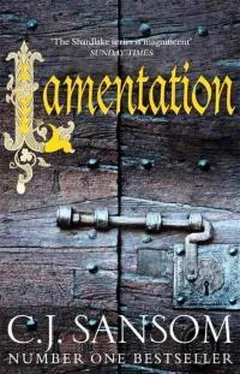I stood, thinking hard. Elizabeth might be the least important of the King’s children, but an assured place working for her household would provide ample protection against unwarranted persecution by Rich. And my official appointment to the Court of Requests was indeed all too likely to go. This new appointment would bring a steady flow of legal work, in the field of property law too, my specialist area.
The Queen Dowager said, ‘A new start, Matthew, for us both.’ She gave a hesitant smile, with something of apology in it.
I looked at her and thought again, how could this sophisticated, beautiful and profoundly moral woman marry a creature like Thomas Seymour? But perhaps Catherine Parr, after so many years of duty, felt the right to her own choice. And Seymour had good looks, if nothing else.
‘You will take the post?’ she asked.
I looked at her, and nodded. ‘I will.’
‘The Lady Elizabeth is not here at present, she is down at Richmond Palace. I would like you to go there now, take your oath to her. I sent a message you might come today. My barge is ready.’
I said, smiling, ‘You knew I would accept.’
‘I knew you would let me do this for you.’
I nodded, slowly, in acknowledgement. ‘Thank you.’
She regarded me seriously. ‘Elizabeth is not yet fourteen, yet already she has the will and intelligence of an adult. There is one thing she asked me to say to all those appointed to work for her. From another girl her age it might be childish boasting, but not Elizabeth.’
‘What is that?’
The Queen Dowager smiled ruefully. ‘My dogs will wear my collars.’
‘Yes,’ I answered quietly. ‘I can imagine her saying that, and meaning it.’
She stepped forward, and now she did take my hand and pressed it tightly. ‘Goodbye, Matthew. I shall never forget all you have done. Or the true regard in which you hold me. Believe me, I understand that, and value it.’
She looked me in the eyes, then stepped away. I was too choked with emotion to reply, as I think she saw, for she rang a bell for the steward to come and take me down to her barge. There were tears in my eyes, which I tried to hide with the depth of my bow.
Outside the steward said, respectfully, that he would ensure Genesis was taken safely back to Chancery Lane for me. He led me outdoors, and I huddled into my coat as we walked down the path between the snow-covered lawns to the river. He helped me into the barge waiting at the landing stage, where two liveried oarsmen sat. They pulled slowly out into the slate-grey Thames. I glanced back once at Chelsea Palace, then turned to face the oarsmen. They carried me downriver, to Elizabeth.
As well as my friends in the writing group, many thanks to Maria Rejt, Liz Cowen, Sophie Orme, Antony Topping, Chris Wellbelove and Wes Miller. Thanks once again to Graham Brown of Fullerton’s for meeting my ceaseless stationery demands.
I would also like to thank Dr Stephen Parish for advice on Henry VIII’s medical symptoms. My interpretation of what happened to Henry during the last months of his life is of course entirely my own.
My last Shardlake novel, Heartstone , centred on the sinking of the King’s warship Mary Rose during the battle of the Solent in July 1545. Since its publication the new Mary Rose Museum has opened in Portsmouth, showing the surviving half of the ship with, as a mirror image, the widest ranging and most beautifully presented collection of Tudor artefacts anywhere in the world. It is truly an extraordinary place, which I have been privileged to be associated with, and I am again grateful to the museum, the staff and especially Rear-Admiral John Lippiett, for continued insights into the vanished world of the 1540s.
Many works were invaluable for my research. Catherine Parr has received some deserved attention in recent years. Janel Mueller’s (ed.) Katherine Parr: Complete Works and Correspondence (Chicago, 2011) is a work of fine scholarship, as well as an exhaustive compendium, which includes the text of Lamentation of a Sinner . Anthony Martinssen trod the biographical ground a generation ago with Queen Katherine Parr (New York, 1971). Two excellent recent biographies are those by Susan James, Catherine Parr (Stroud, 2008) and Linda Porter, Katherine the Queen (London, 2010). For other characters, Dairmaid MacCulloch’s biography, Cranmer (London, 1996), was yet again an invaluable resource. Samuel Rhea Gammon’s Statesman and Schemer: William, First Lord Paget – Tudor Minister (Devon, 1973) is an excellent biography of this unshowy, and therefore perhaps neglected, Tudor politician. Along with McCulloch, he gives the remarkable Bertano affair the attention it deserves. Glyn Redworth’s In Defence of the Church Catholic: The Life of Stephen Gardiner (Oxford, 1990) was very helpful, though it failed to convince me that Gardiner did not play a leading role in the events of 1546. Stephen Alford’s Burghley: William Cecil at the Court of Elizabeth I (Yale, 2008) was helpful on Cecil’s early career and first steps on the political ladder.
Dakota L. Hamilton’s The Household of Queen Katherine Parr (unpublished PhD thesis, Oxford, 1992) was a treasure trove on the structure of the Queen’s Court. Simon Thurley’s Whitehall Palace, The Official Illustrated History (London, 2008), Whitehall Palace, An Architectural History of the Royal Apartments 1240–1690 (London, 1999) and his The Royal Palaces of Tudor England (Yale, 1993) brought the vanished palace back to life, although a good deal of my reconstruction had of course to be imaginative. David Loades’s The Tudor Court (London, 1996) and Maria Hayward’s Dress at the Court of King Henry VIII (London, 2007) were also of great help.
For the wider London world, Liza Picard’s Elizabeth’s London (London, 2005) was once again invaluable and, as with MacCulloch’s Cranmer , never far from my side. James Raven, The Business of Books (Yale, 2007) was especially helpful on the early printing trade. Susan Brigden’s London and the Reformation was another book which, again, was always near to hand. Irvin Buckwalter Horst’s The Radical Brethren: Anabaptism and the English Reformation to 1548 (Holland, 1972) was a mine of information on the early Anabaptists.
My description of Henry’s funeral is based on the account in Robert Hutchinson, The Last Days of Henry VIII (London, 2005).
Thanks also to Amanda Epstein for discussing the legal aspects of the Cotterstoke Will case with me, and to Jeanette Howlett for taking me to Sudeley Castle, where Catherine Parr lived during her sad fourth marriage, and where some beautiful examples of her clothing and possessions survive, as does her tomb, where I left some flowers in memory of Henry’s last, and to me most sympathetic, Queen.
THE LAST YEAR OF Henry VIII’s life saw some of the most tumultuous political events of his entire reign: a major heresy hunt, an attack on the Queen, radical changes in foreign policy, an attempt at reconciliation with the Pope and, at the end of 1546, a switch in control of the Privy Council from religious traditionalists to radicals, who were left in charge of England upon Henry’s death. Unfortunately the sources are very thin, which leaves events open to a wide variety of interpretations. The historian Glyn Redworth has said, rightly, that ‘all accounts are obliged to be in the nature of interpretative essays’. [1] Redworth, G., In Defence of the Church Catholic: The Life of Stephen Gardiner (1990).
My own attempt at interpreting the events of 1546 forms the background to the story of Lamentation (except of course for the fact that Catherine Parr’s Lamentation of a Sinner was not, in the real world, stolen). So I will start with those elements of the story where the facts are clearer, before moving on, for those who may be interested, to my own venture at an ‘interpretative essay’ on what happened in the tumultuous last months of Henry’s life.
Читать дальше








![К Сэнсом - Стенание [другой перевод]](/books/432043/k-sensom-stenanie-drugoj-perevod-thumb.webp)
